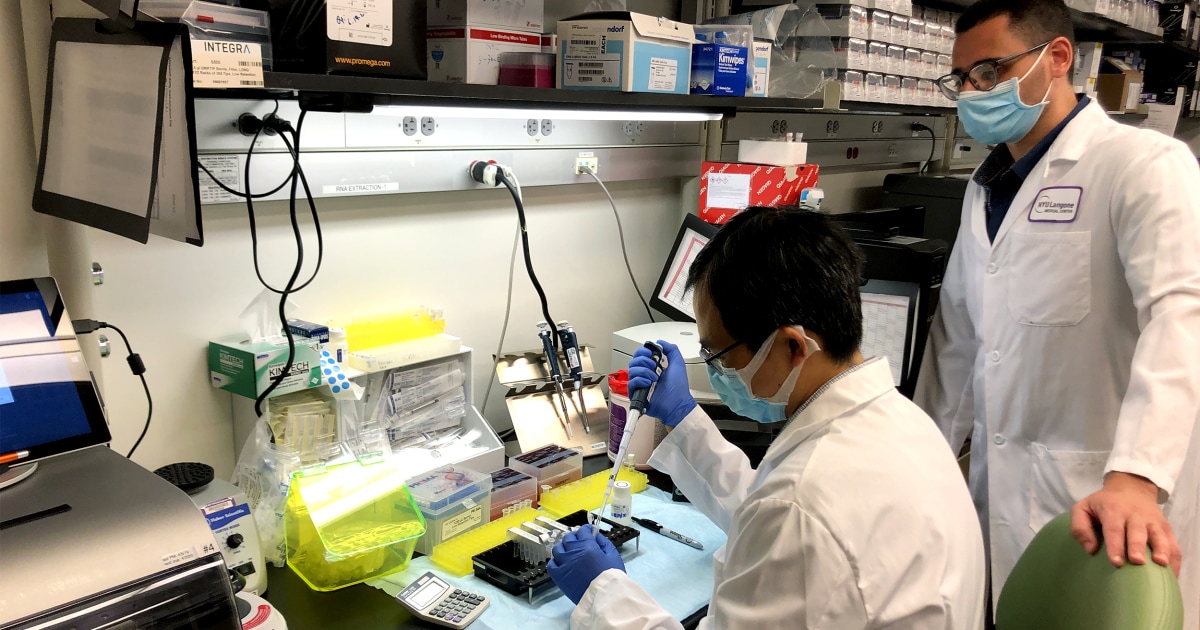
Dr. Matija Snuderl has spent the last couple of months poring over tissue samples collected from the bodies of the recently departed.
As a neuropathologist at NYU Langone Medical Center in New York City, he’s usually diagnosing brain tumors and other brain diseases. But this effort goes beyond his typical duties: Snuderl is among a group of medical experts around the country on a detective-style hunt for missed cases of COVID-19.
“At this point, it is critical to better understand the silent spread that was happening before the outbreak officially began [in New York],” Snuderl said.
As cases surge in some parts of the country, doctors like Snuderl are working to better understand the early trajectory of the virus in hopes of discovering unseen patterns that could help inform future public health policies.
“I think if we better understand how the disease was spreading early on, when the next thing like this happens, we're going to be better prepared, and we're going to be able to act hopefully faster,” Snuderl said.
Currently, there is no coordinated national effort to understand how early and how widely the virus may have been spreading, but this patchwork approach has begun in at least seven other states. Initiatives vary greatly and few teams are working at the directive of state governments. Some have told NBC News they lack staffing or funding to conduct this type of research, which requires special materials to preserve samples for retesting days after an autopsy.
City and county medical examiners and coroners are taking up the bulk of this retrospective work, retesting blood and tissue samples preserved from autopsies to potentially uncover cases that may have gone undetected when testing was less available.
Not only could newly revealed positive results upend the timeline of when COVID-19 took hold throughout the U.S., their efforts could help prevent future deaths by identifying communities that contact tracers and containment strategies should target. Medical examiners like Dr. Thomas Gilson say their insights are a crucial part of the long-term public health surveillance mechanism.
“If all I had for information was how many health care workers tested positive and how many people who were really sick test positive, I really have the potential to miss a lot of people out in the community who either aren't that sick or are sick and don't access the health care system,” said Gilson, who oversees the efforts in Cuyahoga County, Ohio, the county with the second-highest number of infections in the state.
Thanks to funding from the county, Gilson and his team have been able to perform antibody testing on 350 deceased people. About 3% came back positive, but additional testing on tissue samples pulled from the same bodies came back negative. He believes the antibody tests were false positives and cautions against relying on antibody testing for retrospective research.
“These results indicate that the number of people infected in our community is still relatively low,” Gilson said.
A similar effort is underway in California, which is the only state to have requested that all of its medical examiner offices re-examine past cases.
“People are dying at home without any medical diagnosis — we're the last chance to catch those people and make sure that steps are taken to help contain the virus and spread,” said Dr. Christopher Young, the Ventura County chief medical examiner, who has started reviewing files as far back as December.
The initial look-back request was issued by Gov. Gavin Newsom and the state Department of Health in late April and asked teams to reconsider cases dating back to December 2019, before China announced the identification of the virus.
The effort was triggered by Santa Clara County’s identification of two deaths on Feb. 6 and Feb. 17 as positive for SARS-CoV-2, the virus that causes COVID-19 — predating the first established death in the country by weeks.
“As a physician and a forensic pathologist, I definitely would like to make sure we have accurate causes and that's why we do all the tests that we do on any case: to try to come to the right conclusion,” Young said.
Some medical examiners have access to facilities that can test autopsy tissue samples. California health officials send their specimens to the Centers for Disease Control and Prevention for testing, but certain criteria must be met and results can take up to eight weeks, the officials said.
The effort has been slow to bear results — diminished in part by the state’s recent record daily numbers, as teams work to keep up with the flood of new cases.
“We are still very, very much in the thick of things,” said Andrea Bowers, spokeswoman for the Imperial County Public Health Department. "So, we've had to bring in additional contact tracers, case investigators and epidemiology staff, and so they really have not had a moment to kind of look backwards.”
As caseloads swell across the U.S., teams in Washington, Nevada, New Mexico, Massachusetts and Illinois are also re-examining blood and tissue samples to identify any potential COVID-19 cases that were overlooked.
Snuderl, of NYU Langone, is convinced the virus was spreading in New York well before the first official case was announced on March 1. His theory was bolstered by a recent finding by Mount Sinai Hospital researchers that some New Yorkers had COVID-19 antibodies present in their blood more than a week before the first case was announced in New York City.
"We cannot go back in time, we can't turn the clock back and we cannot change what happened," Snuderl said, "but I think it will definitely help us to prepare for the next pandemic."
Health - Latest - Google News
July 11, 2020 at 04:04PM
https://ift.tt/2W9g32k
Inside the detective-style hunt for missed COVID-19 cases - NBC News
Health - Latest - Google News
https://ift.tt/2zrj9Ud
Bagikan Berita Ini














0 Response to "Inside the detective-style hunt for missed COVID-19 cases - NBC News"
Post a Comment